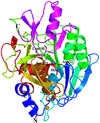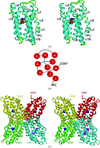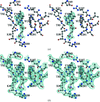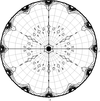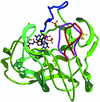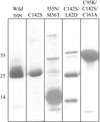issue contents
May 2005 issue

Cover illustration: Crystal structure of the TenA homolog PF1337 tetramer with CPK representations of HMP-P (magenta, subunit A) and inorganic phosphate (blue, subunits B-D) (p. 589). The different subunits are colored in cyan (A), red (B), yellow (C) and green (D).
research papers
Open  access
access
 access
accessStructures of binary complexes of a human deletion mutant of glucose-6-phosphate dehydrogenase with G6P and with NADP+ show substrate and coenzyme binding and confirm the need for a cis proline (172) near the active site. A possible interaction between a second, structural (non-coenzyme) NADP+ and the bound G6P is suggested and its implication considered.
The exact number and the three-dimensional localization of the essential calcium sites within the mammalian prohormone/proprotein convertase furin have been determined by collecting X-ray diffraction data on either side of the Ca K absorption edge and by calculating a novel type of double difference map from these anomalous scattering data.
It is shown that one single point mutation on the surface of cyclophilin D changed the crystallization properties of the protein to such an extent that crystals of excellent diffraction quality and extreme stability could be obtained.
Screening parameter space using a high-throughput pipeline increases the success of protein structure determination.
AVR4 has been crystallized in apo and biotin-complexed forms and their structures have been determined at high resolution.
Fully deuterated cytochrome P450cam has been produced and crystallized in order to aid in the determination of its neutron crystallographic structure.
Open  access
access
 access
accessThe structure of myo-inositol monophosphatase, the putative target of lithium therapy for bipolar disorder, has been determined in complex with the physiological magnesium ion ligands. A detailed three-metal mechanism is proposed; the role of the substrate 6-OH group is shown to be in the direct stabilization of the transition state, and mechanisms are proposed for the possible modes of Li+ and Mg2+ inhibition.
PDB reference: myo-inositol monophosphatase, 2bji, r2bjisf
The moduli and phases of non-measured reflections are estimated to improve the quality of electron-density maps.
COHbC (β6K) and COHbS (β6V) crystallize in the R2 quaternary form at neutral pH and low ionic strength. These are the first detailed high-resolution R2 quaternary structures reported for human hemoglobins crystallized under conditions approaching physiological.
Neutron diffraction is being used to help determine the positions of H atoms within the active site of DHFR when bound to the inhibitor methotrexate.
The X-ray crystal structure of subtilisin Carlsberg bound to the broad-specificity protein proteinase inhibitor OMTKY3 reveals two distinct conformations of the inhibitor and rationalizes previous thermodynamic data in terms of additivity.
PDB reference: subtilisin Carlsberg–OMTKY3 complex, 1yu6, r1yu6sf
The structure of the TenA enzyme from P. furiosus is reported with 4-amino-5-hydroxymethyl-2-methylpyrimidine phosphate bound at its active site.
PDB reference: TenA, 1rtw, r1rtwsf
The crystal structures of pyridoxine 5′-phosphate oxidase give an insight into the mechanistic pathway of the enzyme.
PDB reference: pyridoxine 5′-phosphate oxidase, 1wv4, r1wv4sf
The structure of the B. viridis reaction center is reported from cryogenic data collection.
PDB reference: photosynthetic reaction center, 1vrn, r1vrnsf
After phasing a data set with MAD, the crystals were found to be tetartohedrally twinned. A special refinement protocol is described that was established to deal with these data. The resulting structure explains the success of MAD in phasing the data, as well as the reasons for tetartohedral twinning.
The structures of human thymidylate synthase under low-salt conditions and in 2.0 M ammonium sulfate are very similar. The higher resolution obtained enabled the location of a hydrophobic ligand stabilizing the inactive conformation of loop 181–197.
PDB reference: thymidylate synthase, 1ypv, r1ypvsf
The structure of the complex between hen egg-white lysozyme and the Fab HyHEL-5 has been re-evaluated at 1.7 Å resolution. The structural results have been compared with the results of isothermal titration calorimetry.
PDB reference: HyHEL-5–lysozyme complex, 1yqv, r1yqvsf
short communications
The Secondary Structural Elements of Proteins (SSEP) database is an integrated and comprehensive knowledge base for accessing information related to all the secondary-structural elements present in non-redundant (25 and 90%) protein chains. The new version 2.0 is described here.
The Conformation Angles Data Base (CADB) is a comprehensive, authoritative and timely knowledge base with a powerful query engine developed to facilitate the retrieval of information related to the conformational angles (main chain and side chain) of the amino-acid residues present in non-redundant (both 25 and 90%) data sets. An updated version is decribed here..
Crystals of the blue copper protein amicyanin of dimensions ∼2 × 1.3 × 1 mm, crystallized and macroseeded repeatedly using solutions made in D2O throughout the crystal-growth process, diffracted neutrons to a resolution of 1.9 Å.
Open  access
access
 access
accessA method is described for preparing crystals for mass spectrometry. An example of its use is given.
Open  access
access
 access
accessA soluble recombinant form of the 3C protease from foot-and-mouth disease virus was produced by substitution of two surface-exposed cysteines. Crystals that diffract to high resolution (1.9 Å) were obtained with a simple optimization strategy using standard screening solutions.


 journal menu
journal menu





















